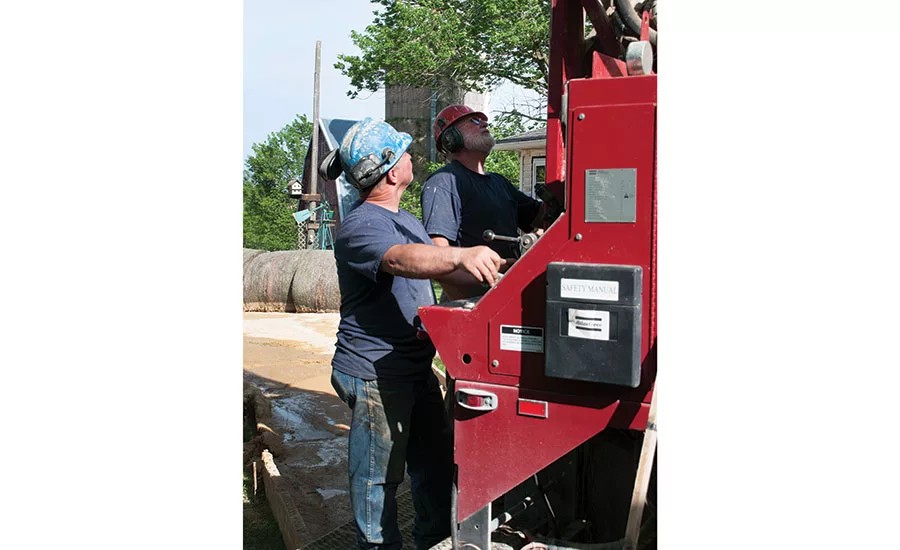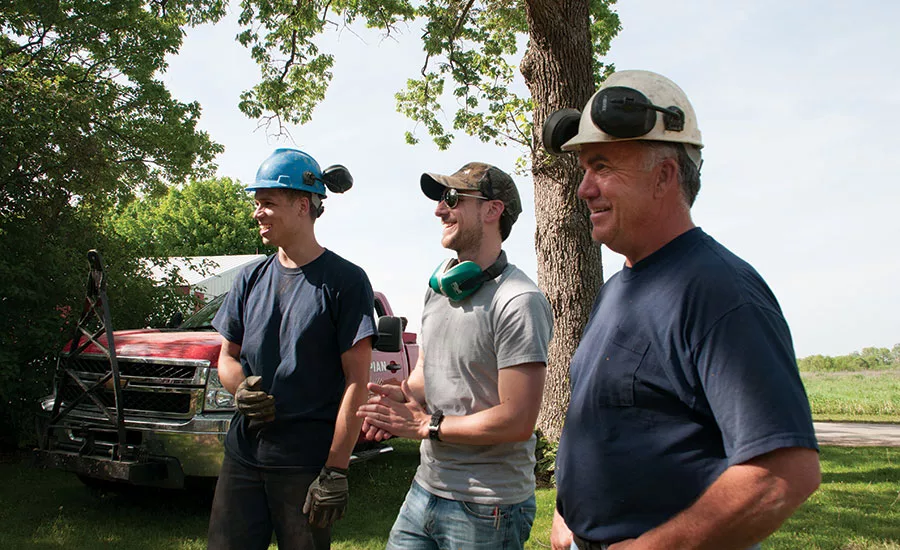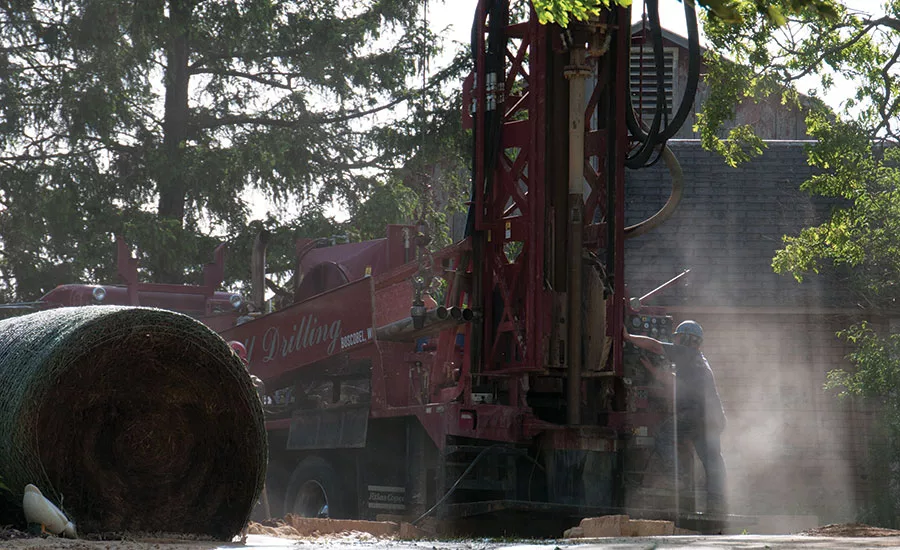Drilling Contractor Finds Solutions for Tough Karst Formations

Corpian Well Drilling Inc. owner Mike Beinborn encounters a lot of unpredictable karst formations, and relies on his TH60 to get the job done. Source: Atlas Copco


Corpian crew member Khalen Greene, left, joins Atlas Copco Midwest sales representative Clark Herbst and Corpian owner Mike Beinborn for an end-of-day assessment on a water well jobsite. Source: Atlas Copco photos

When a farmer is out of water, it’s an emergency situation. Corpian’s TH60 helps them respond quickly and effectively, even in karst formations.
The entire service area for Corpian Well Drilling Inc. of Boscobel, Wis., lies within the Driftless Area. Although the area was not ground level by historic glaciers, it did experience glacial runoff when they melted. The inundations not only carved out rivers and streams, but percolated down through permeable limestone, creating a formation known as karst that weaves through unpredictable strata. Working in karst is about as tough as water well drilling gets.
Mike Beinborn, owner of Corpian Well Drilling Inc., describes the formation’s conditions: “Karst throws you so many curve balls. A lot of guys won’t drill in this. You think you know the formation — you drill through a lot of lime rock with large crevices and voids, then soft sandstone, some shale. But you move 10 feet over, same elevation, same aquifer, it’s completely different. Suddenly there is no soft shale, or there is no soft sandstone.”
A driller never knows when he’ll hit fractures, fissures, crevices, voids, and caves on the way down — only that he will hit them, getting no returns at all.
“And then a driller might think he’s found really good rock at 100 and sometimes over 300 feet, but he shouldn’t trust it.” Beinborn explains that drillers who case off to the first hard rock may lose everything again 60 feet past the end of the casing. When this happens you have two choices, you can either keep the hole open the full 6 inches and retrieve the casing, cutting off each section as it comes up, or install a 5-inch liner and risk hitting another bad spot further below the casing. What’s best for the customer is to keep the hole open the full 6 inches.
However, if they are not successful at pulling their casing, they may have to abandon it, fill it with cement, offset and then start a new hole. “That extra cost isn’t passed onto the customer,” Beinborn says. “That comes out of your own pocket.”
Beinborn devised a means of bettering his odds in these risky drilling conditions, which might not surprise those who knew his maternal grandfather’s ingenuity and “make it work” attitude.
Getting Creative for Karst
Company founder Ken Corpian was as unique a driller as they come. A third-generation driller himself, Corpian had lost his right arm in a rock crushing plant in 1940 but continued his drilling career. Corpian was all about hard work and finding a better way of doing things.
He was featured in the February 1964 issue of National Driller magazine — not for being “an extremely active” one-armed driller, but for a drill rig innovation. He had retooled a 10-R Bucyrus-Erie rotary rig to enable pneumatic drilling with down-the-hole hammers. He had been boring wells with his own rig almost three years before Bucyrus-Erie had a production model like it available, its 10-R H drill rig. The Corpian rig was unofficially declared the commercial rig’s prototype.
“He did it because he believed he had to,” Beinborn says. “The rock was just too hard for rotary in the quarries he was working. Down-the-hole drilling wasn’t new, but it wasn’t available in the size of rig he needed. One was currently being designed, but he wasn’t going to sit around waiting for it.”
Beinborn shares the “do whatever it takes” attitude so fundamental to his grandfather’s work ethic. Under his leadership, Corpian Well Drilling has been a successful well drilling company since 1983, when he switched from being a pump installer for 14 years with his dad, and began well drilling with his grandfather. Mike and his wife, Nancy, took over the business in the spring of 1985.
A large part of its financial stability is due to his skill at bidding jobs. “Everyone wants you to tell exactly what a well will cost,” Beinborn says. “But you can’t do that here. In the karst you can drill wells 20 feet apart that are totally different. They don’t cost the same. You have to do your homework.”
Another reason for the company’s financial stability is a dependable rig Beinborn uses in his unique approach to karst drilling. “The TH60 I’m using right now does more work in a year than five rigs my grandfather was using in the ’60s.”
But a good rig wouldn’t mean much without good product support. Beinborn said that’s one of the things he values so much about Atlas Copco: “If I need to call at 7 o’clock on a Friday night, somebody talks to me. That’s worth a million bucks to me.”
Beinborn says he also likes Atlas Copco’s constant innovation. “Each time I upgrade, every rig just gets better and better.” One of the improvements he liked about the TH60 early on was a shift to larger feed cable sheaves with automatic cable tensioning. “The larger diameter sheaves increase safety,” Beinborn says. “You just don’t see the wear and fraying. It used to be you replaced cables every year. We don’t have that anymore.”
Urgent Well
The well being drilled this day is a typical example of how the Atlas Copco TH60 supports Beinborn’s karst-drilling method. Beinborn received the call on a Sunday night from a livestock producer whose well had failed. Luckily his animals had just sold and were hauled off before the failure; however, new livestock was being delivered and would need fresh water. Corpian’s TH60 was on its jacks drilling between the house and garage the very next morning. “We’ll always drop what we’re doing to run to a farmer out of water. It’s an emergency situation.”
Getting to the site was a roller coaster ride on narrow, winding, potholed tar roads covered in loose rock and sand that rose and fell steeply through the mountain-like terrain of the Driftless Area. “It’s no problem for the rig,” Beinborn says.
The 2014 TH60 featured a Peterbilt 367 with a 600-horsepower Cummins ISX engine. The same engine powers drilling operations through a transfer case, supporting the rig’s 40,000-pound pullback capability, two-speed rotary head, 18,000-pound casing winch, and a 900 cfm / 350 psi compressor.
On site, Corpian’s chief driller Rick Kazda slipped the rig between the landowner’s house and garage, avoiding ornate flower beds, several nearby outbuildings, a corral and loading chute to the rear of the house, and a wall of fir trees. Kazda leveled the rig and set up for drilling a 6-inch pilot hole with an Atlas Copco Secoroc QL 60 hammer and Secoroc concave 6-inch bit. The hole would be opened to 10 inches for surface casing using a QL 80 hammer.
Drilling a pilot hole first differs from the typical water well drilling method used elsewhere. Many water well drillers start with a wide diameter hole, find the bedrock, case, grout, then drill the smaller production bore to the desired depth. Beinborn, however, starts with the smaller bore in a method similar to exploration or definition drilling.
Kazda located the competent bedrock first with the 6-inch bit, and then continued drilling farther, “just to the tip of the aquifer.” Kazda ran the hammer on about 250 psi injecting foam to help lift cuttings. He nursed the rate of penetration, constantly adjusting to keep efficiently hammering as he felt his way through the strata. From the surface he went through 34 feet of loose rock and clay before encountering 176 feet of limestone and crevices. Then, after 40 feet of soft sandstone, he hit soft shale prone to swelling and sloughing. At 264 feet he found what he was looking for, hard shale. He continued to 340 feet, assuring he was in sound bedrock.
Now that he knew exactly where he was going with the casing and what he would be drilling through, he was ready to open the hole for surface casing. Kazda tripped out to open the hole to 273 feet, setting 6-inch casing in the hard shale.
Beinborn prefers the security of a 2-inch grouted annulus, which gives him assurance of a sound seal in such an inconsistent formation. Because the highly varied strata can throw off even a shallow well bore’s straightness, perfect concentric casing placement in wells that are as deep as 700 feet is just too difficult, so Beinborn sticks with a 2-inch annulus.
Kazda completed the 6-inch production bore to a total depth of 380 feet. Once water was flowing and all looked good, the grouting began. On occasion, when cement hits an unpredictable void and runs laterally, they have to call the state for permission to use bentonite to seal off the bad areas and continue grouting to the surface.
Beinborn also goes the extra mile developing the well, using chlorinated makeup water. “This gives us a foot up on a good bacterial water sample.” It’s all part of his Corpian heritage. Beinborn does “whatever it takes,” just like his grandfather, to “make it work.”
Looking for a reprint of this article?
From high-res PDFs to custom plaques, order your copy today!



